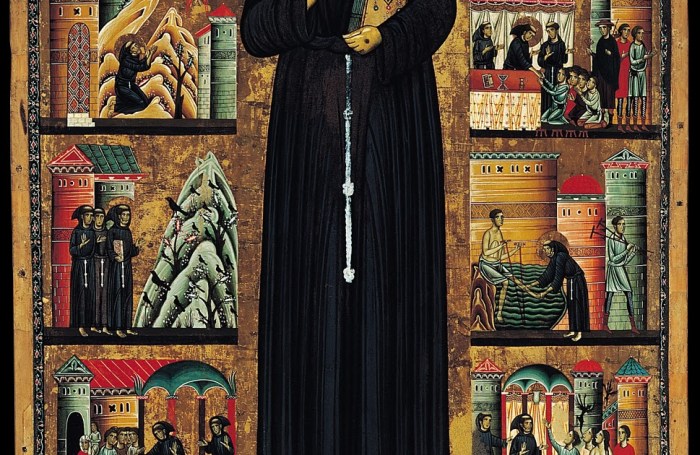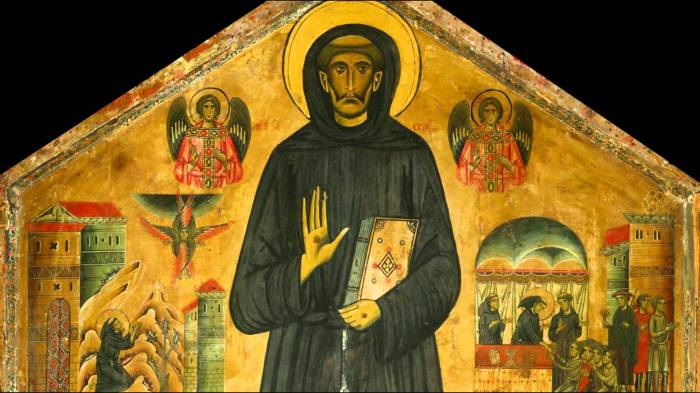Bonaventura berlinghieri st francis altarpiece – Bonaventura Berlinghieri’s St. Francis Altarpiece is a significant work of early Italian art that showcases the artist’s unique style and techniques. This masterpiece offers a glimpse into the religious beliefs and artistic traditions of the medieval period.
The altarpiece’s composition and iconography reflect the life and teachings of St. Francis of Assisi. Berlinghieri’s use of tempera on wood as a medium, along with his innovative techniques, create a sense of depth, perspective, and realism in the painting.
Introduction: Bonaventura Berlinghieri St Francis Altarpiece

The “St. Francis Altarpiece” by Bonaventura Berlinghieri holds immense significance in the evolution of Italian art. Created in the 13th century, it represents a pivotal moment in the transition from Byzantine iconography to the naturalistic style that would later define the Renaissance.
Berlinghieri’s innovative techniques and unique artistic vision contributed to the development of a new visual language that would influence subsequent generations of artists.
Berlinghieri’s artistic style, rooted in the Byzantine tradition, was characterized by its use of vibrant colors, flat, stylized figures, and a strong emphasis on symbolism. However, he also incorporated elements of naturalism, such as three-dimensional modeling and a concern for spatial relationships, which would become hallmarks of the Renaissance style.
Composition and Iconography

The altarpiece consists of a central panel depicting St. Francis of Assisi receiving the stigmata, surrounded by 24 smaller panels narrating scenes from the saint’s life and miracles. The central panel follows the traditional Byzantine iconography, with St. Francis standing in a frontal pose, his body marked with the five wounds of Christ.
The surrounding panels depict events such as the saint’s encounter with the leper, his preaching to the birds, and his death.
The iconography of the altarpiece is rich in symbolism. The stigmata, for example, represents St. Francis’s deep connection to Christ and his willingness to suffer for the sake of his faith. The animals in the surrounding panels symbolize the saint’s love for all creatures and his ability to communicate with them.
Artistic Techniques and Materials
The altarpiece is painted in tempera on wood, a technique commonly used in medieval art. Tempera involves mixing pigments with egg yolk, resulting in a durable and vibrant finish. Berlinghieri’s use of this medium allowed him to create a rich and textured surface, with subtle gradations of color and fine details.
To create depth and perspective in the painting, Berlinghieri employed various techniques, including the use of overlapping figures, foreshortening, and atmospheric perspective. He also used a limited color palette, with shades of blue, red, and gold dominating the composition.
Symbolism and Meaning
Beyond its literal depiction of St. Francis’s life, the altarpiece carries a profound symbolic meaning. The stigmata, for example, symbolizes the saint’s role as a mediator between God and humanity. The animals represent the saint’s connection to the natural world and his belief in the equality of all creatures.
The architectural details, such as the Gothic arches and the pointed towers, evoke a sense of the sacred and the heavenly.
Overall, the altarpiece serves as a visual representation of St. Francis’s virtues, his devotion to God, and his love for all living things. It is a testament to Berlinghieri’s artistic skill and his ability to convey complex theological concepts through visual imagery.
Historical and Cultural Context

The “St. Francis Altarpiece” was created during a period of significant religious and social change in Italy. The rise of the Franciscan Order, founded by St. Francis in the 13th century, emphasized poverty, humility, and a deep connection to nature.
Berlinghieri’s altarpiece reflects the growing popularity of the Franciscan Order and its influence on the artistic and cultural landscape of the time.
The altarpiece also provides insights into the medieval worldview and the importance of religious devotion. It serves as a reminder of the profound influence of Christianity on medieval society and the role of art in conveying religious beliefs and values.
Comparison to Other Works
The “St. Francis Altarpiece” can be compared to other works by Berlinghieri, such as his “Crucifixion” in the Museo Civico in San Gimignano. Both works share similar characteristics in terms of their use of tempera on wood, their vibrant colors, and their attention to detail.
However, the “Crucifixion” depicts a more somber and dramatic scene, while the “St. Francis Altarpiece” conveys a sense of serenity and spiritual joy.
The altarpiece can also be compared to works by contemporary artists, such as Cimabue’s “Maestà” in the Uffizi Gallery in Florence. Both works are large-scale altarpieces that depict scenes from the life of Christ or saints. However, Cimabue’s work is more naturalistic in style, with a greater emphasis on three-dimensional modeling and perspective.
FAQ Insights
What is the significance of the St. Francis Altarpiece?
The St. Francis Altarpiece is a significant work of early Italian art that showcases the artist’s unique style and techniques. It reflects the religious beliefs and artistic traditions of the medieval period.
What are the main characteristics of Berlinghieri’s artistic style?
Berlinghieri’s style is characterized by its use of tempera on wood as a medium, as well as his innovative techniques to create depth, perspective, and realism in his paintings.
What is the symbolic meaning behind the various elements of the altarpiece?
The altarpiece’s composition and iconography reflect the life and teachings of St. Francis of Assisi. The stigmata, the animals, and the architectural details all carry symbolic meanings that contribute to the overall message and interpretation of the work.